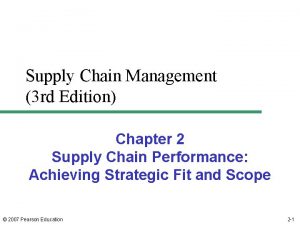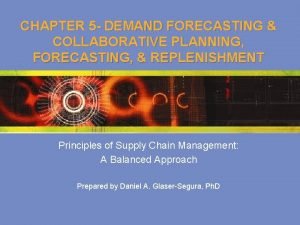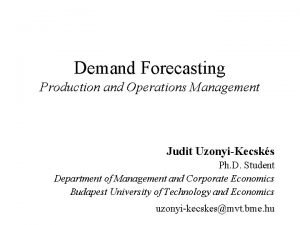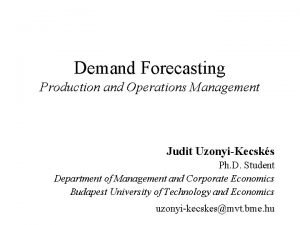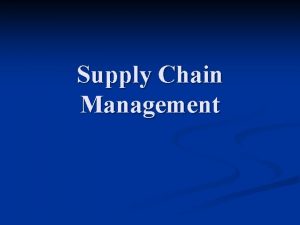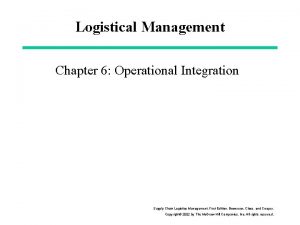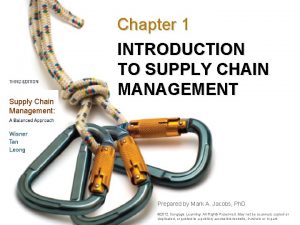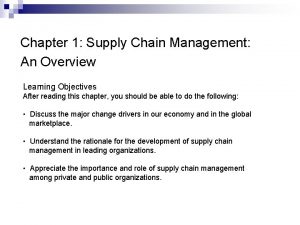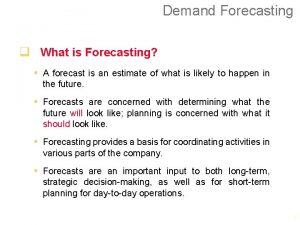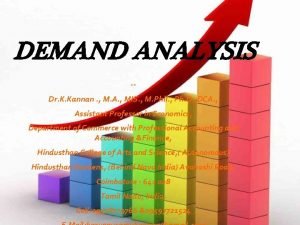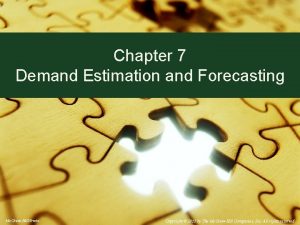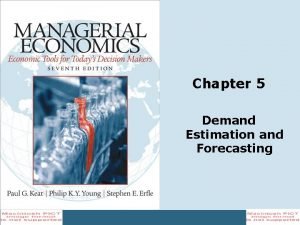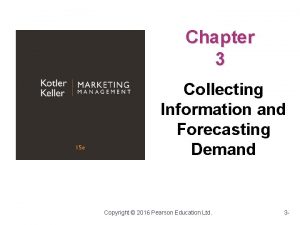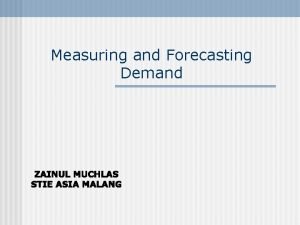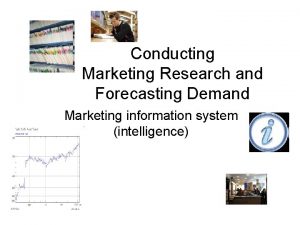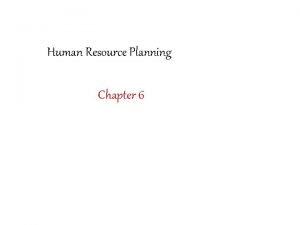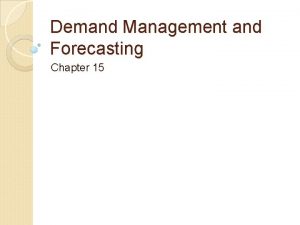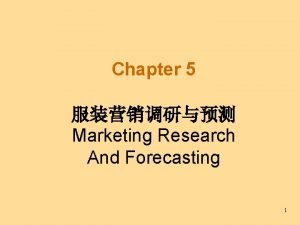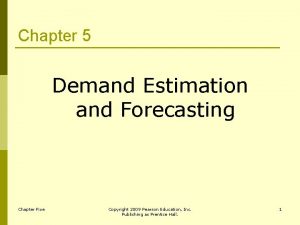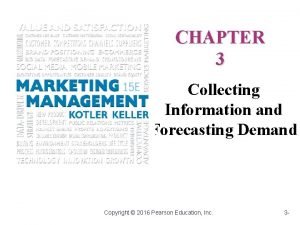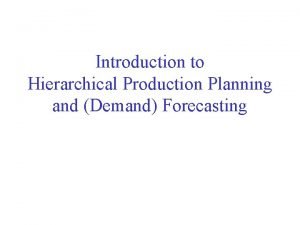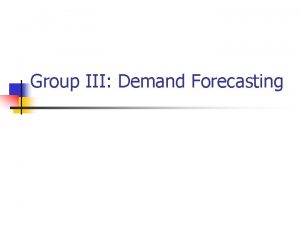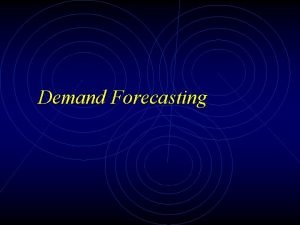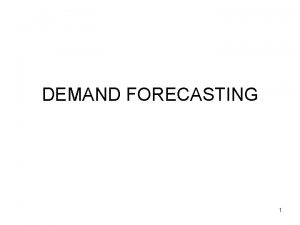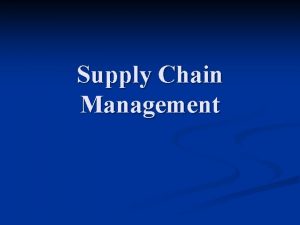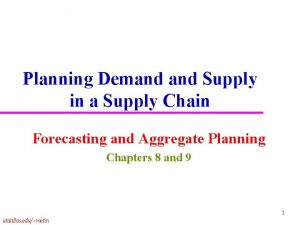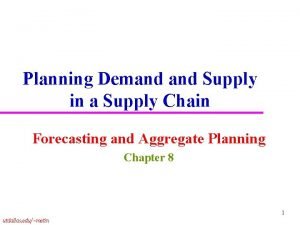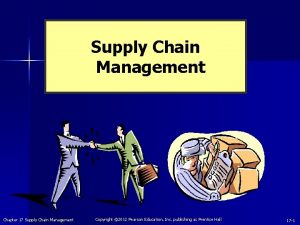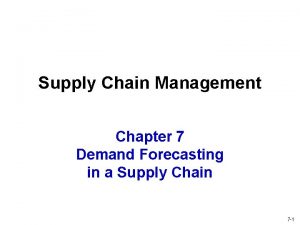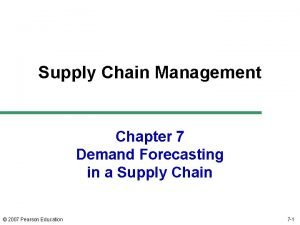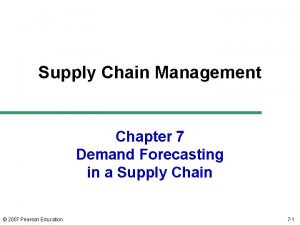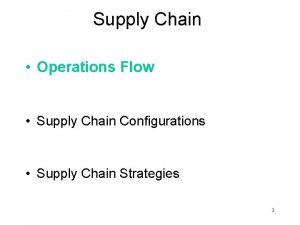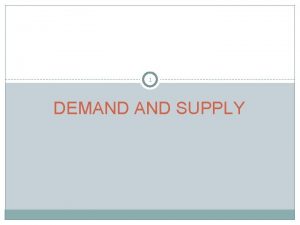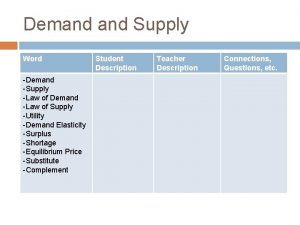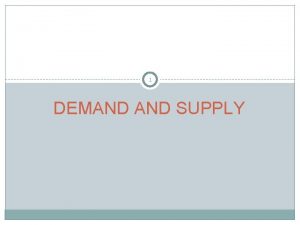Supply Chain Management Chapter 7 Demand Forecasting in

















![Deseasonalizing Demand [Dt-(p/2) + Dt+(p/2) + S 2 Di] / 2 p for p Deseasonalizing Demand [Dt-(p/2) + Dt+(p/2) + S 2 Di] / 2 p for p](https://slidetodoc.com/presentation_image_h2/99491fbefdba8fd921824cfa67514224/image-18.jpg)

























- Slides: 43

Supply Chain Management Chapter 7 Demand Forecasting in a Supply Chain © 2007 Pearson Education 7 -1

Outline u. The role of forecasting in a supply chain u. Characteristics of forecasts u. Components of forecasts and forecasting methods u. Basic approach to demand forecasting u. Time series forecasting methods u. Measures of forecast error u. Forecasting demand at Tahoe Salt u. Forecasting in practice © 2007 Pearson Education 7 -2

Role of Forecasting in a Supply Chain u. The basis for all strategic and planning decisions in a supply chain u. Used for both push and pull processes u. Examples: – Production: scheduling, inventory, aggregate planning – Marketing: sales force allocation, promotions, new production introduction – Finance: plant/equipment investment, budgetary planning – Personnel: workforce planning, hiring, layoffs u. All of these decisions are interrelated © 2007 Pearson Education 7 -3

Characteristics of Forecasts u. Forecasts are always wrong. Should include expected value and measure of error. u. Long-term forecasts are less accurate than shortterm forecasts (forecast horizon is important) u. Aggregate forecasts are more accurate than disaggregate forecasts © 2007 Pearson Education 7 -4

Forecasting Methods u. Qualitative: primarily subjective; rely on judgment and opinion u. Time Series: use historical demand only – Static – Adaptive u. Causal: use the relationship between demand some other factor to develop forecast u. Simulation – Imitate consumer choices that give rise to demand – Can combine time series and causal methods © 2007 Pearson Education 7 -5

Components of an Observation Observed demand (O) = Systematic component (S) + Random component (R) Level (current deseasonalized demand) Trend (growth or decline in demand) Seasonality (predictable seasonal fluctuation) • Systematic component: Expected value of demand • Random component: The part of the forecast that deviates from the systematic component • Forecast error: difference between forecast and actual demand © 2007 Pearson Education 7 -6

Time Series Forecasting Forecast demand for the next four quarters. © 2007 Pearson Education 7 -7

Time Series Forecasting © 2007 Pearson Education 7 -8

Forecasting Methods u. Static u. Adaptive – – Moving average Simple exponential smoothing Holt’s model (with trend) Winter’s model (with trend and seasonality) © 2007 Pearson Education 7 -9

Basic Approach to Demand Forecasting u. Understand the objectives of forecasting u. Integrate demand planning and forecasting u. Identify major factors that influence the demand forecast u. Understand identify customer segments u. Determine the appropriate forecasting technique u. Establish performance and error measures for the forecast © 2007 Pearson Education 7 -10

Time Series Forecasting Methods u. Goal is to predict systematic component of demand – Multiplicative: (level)(trend)(seasonal factor) – Additive: level + trend + seasonal factor – Mixed: (level + trend)(seasonal factor) u. Static methods u. Adaptive forecasting © 2007 Pearson Education 7 -11

Static Methods u. Assume a mixed model: Systematic component = (level + trend)(seasonal factor) Ft+l = [L + (t + l)T]St+l = forecast in period t for demand in period t + l L = estimate of level for period 0 T = estimate of trend St = estimate of seasonal factor for period t Dt = actual demand in period t Ft = forecast of demand in period t © 2007 Pearson Education 7 -12

Static Methods u. Estimating level and trend u. Estimating seasonal factors © 2007 Pearson Education 7 -13

Estimating Level and Trend u. Before estimating level and trend, demand data must be deseasonalized u. Deseasonalized demand = demand that would have been observed in the absence of seasonal fluctuations u. Periodicity (p) – the number of periods after which the seasonal cycle repeats itself – for demand at Tahoe Salt (Table 7. 1, Figure 7. 1) p = 4 © 2007 Pearson Education 7 -14

Time Series Forecasting (Table 7. 1) Forecast demand for the next four quarters. © 2007 Pearson Education 7 -15

Time Series Forecasting (Figure 7. 1) © 2007 Pearson Education 7 -16

Estimating Level and Trend u. Before estimating level and trend, demand data must be deseasonalized u. Deseasonalized demand = demand that would have been observed in the absence of seasonal fluctuations u. Periodicity (p) – the number of periods after which the seasonal cycle repeats itself – for demand at Tahoe Salt (Table 7. 1, Figure 7. 1) p = 4 © 2007 Pearson Education 7 -17
![Deseasonalizing Demand Dtp2 Dtp2 S 2 Di 2 p for p Deseasonalizing Demand [Dt-(p/2) + Dt+(p/2) + S 2 Di] / 2 p for p](https://slidetodoc.com/presentation_image_h2/99491fbefdba8fd921824cfa67514224/image-18.jpg)
Deseasonalizing Demand [Dt-(p/2) + Dt+(p/2) + S 2 Di] / 2 p for p even Dt = (sum is from i = t+1 -(p/2) to t+1+(p/2)) S Di / p for p odd (sum is from i = t-(p/2) to t+(p/2)), p/2 truncated to lower integer © 2007 Pearson Education 7 -18

Deseasonalizing Demand For the example, p = 4 is even For t = 3: D 3 = {D 1 + D 5 + Sum(i=2 to 4) [2 Di]}/8 = {8000+10000+[(2)(13000)+(2)(23000)+(2)(34000)]}/8 = 19750 D 4 = {D 2 + D 6 + Sum(i=3 to 5) [2 Di]}/8 = {13000+18000+[(2)(23000)+(2)(34000)+(2)(10000)]/8 = 20625 © 2007 Pearson Education 7 -19

Deseasonalizing Demand Then include trend Dt = L + t. T where Dt = deseasonalized demand in period t L = level (deseasonalized demand at period 0) T = trend (rate of growth of deseasonalized demand) Trend is determined by linear regression using deseasonalized demand as the dependent variable and period as the independent variable (can be done in Excel) In the example, L = 18, 439 and T = 524 © 2007 Pearson Education 7 -20

Time Series of Demand (Figure 7. 3) © 2007 Pearson Education 7 -21

Estimating Seasonal Factors Use the previous equation to calculate deseasonalized demand for each period St = Dt / Dt = seasonal factor for period t In the example, D 2 = 18439 + (524)(2) = 19487 D 2 = 13000 S 2 = 13000/19487 = 0. 67 The seasonal factors for the other periods are calculated in the same manner © 2007 Pearson Education 7 -22

Estimating Seasonal Factors (Fig. 7. 4) © 2007 Pearson Education 7 -23

Estimating Seasonal Factors The overall seasonal factor for a “season” is then obtained by averaging all of the factors for a “season” If there are r seasonal cycles, for all periods of the form pt+i, 1<i<p, the seasonal factor for season i is Si = [Sum(j=0 to r-1) Sjp+i]/r In the example, there are 3 seasonal cycles in the data and p=4, so S 1 = (0. 42+0. 47+0. 52)/3 = 0. 47 S 2 = (0. 67+0. 83+0. 55)/3 = 0. 68 S 3 = (1. 15+1. 04+1. 32)/3 = 1. 17 S 4 = (1. 66+1. 68+1. 66)/3 = 1. 67 © 2007 Pearson Education 7 -24

Estimating the Forecast Using the original equation, we can forecast the next four periods of demand: F 13 = (L+13 T)S 1 = [18439+(13)(524)](0. 47) = 11868 F 14 = (L+14 T)S 2 = [18439+(14)(524)](0. 68) = 17527 F 15 = (L+15 T)S 3 = [18439+(15)(524)](1. 17) = 30770 F 16 = (L+16 T)S 4 = [18439+(16)(524)](1. 67) = 44794 © 2007 Pearson Education 7 -25

Adaptive Forecasting u. The estimates of level, trend, and seasonality are adjusted after each demand observation u. General steps in adaptive forecasting u. Moving average u. Simple exponential smoothing u. Trend-corrected exponential smoothing (Holt’s model) u. Trend- and seasonality-corrected exponential smoothing (Winter’s model) © 2007 Pearson Education 7 -26

Basic Formula for Adaptive Forecasting Ft+1 = (Lt + l. T)St+1 = forecast for period t+l in period t Lt = Estimate of level at the end of period t Tt = Estimate of trend at the end of period t St = Estimate of seasonal factor for period t Ft = Forecast of demand for period t (made period t-1 or earlier) Dt = Actual demand observed in period t Et = Forecast error in period t At = Absolute deviation for period t = |Et| MAD = Mean Absolute Deviation = average value of At © 2007 Pearson Education 7 -27

General Steps in Adaptive Forecasting u. Initialize: Compute initial estimates of level (L 0), trend (T 0), and seasonal factors (S 1, …, Sp). This is done as in static forecasting. u. Forecast: Forecast demand for period t+1 using the general equation u. Estimate error: Compute error Et+1 = Ft+1 - Dt+1 u. Modify estimates: Modify the estimates of level (Lt+1), trend (Tt+1), and seasonal factor (St+p+1), given the error Et+1 in the forecast u. Repeat steps 2, 3, and 4 for each subsequent period © 2007 Pearson Education 7 -28

Moving Average u Used when demand has no observable trend or seasonality u Systematic component of demand = level u The level in period t is the average demand over the last N periods (the N-period moving average) u Current forecast for all future periods is the same and is based on the current estimate of the level Lt = (Dt + Dt-1 + … + Dt-N+1) / N Ft+1 = Lt and Ft+n = Lt After observing the demand for period t+1, revise the estimates as follows: Lt+1 = (Dt+1 + Dt + … + Dt-N+2) / N Ft+2 = Lt+1 © 2007 Pearson Education 7 -29

Moving Average Example From Tahoe Salt example (Table 7. 1) At the end of period 4, what is the forecast demand for periods 5 through 8 using a 4 -period moving average? L 4 = (D 4+D 3+D 2+D 1)/4 = (34000+23000+13000+8000)/4 = 19500 F 5 = 19500 = F 6 = F 7 = F 8 Observe demand in period 5 to be D 5 = 10000 Forecast error in period 5, E 5 = F 5 - D 5 = 19500 - 10000 = 9500 Revise estimate of level in period 5: L 5 = (D 5+D 4+D 3+D 2)/4 = (10000+34000+23000+13000)/4 = 20000 F 6 = L 5 = 20000 © 2007 Pearson Education 7 -30

Simple Exponential Smoothing u Used when demand has no observable trend or seasonality u Systematic component of demand = level u Initial estimate of level, L 0, assumed to be the average of all historical data L 0 = [Sum(i=1 to n)Di]/n Current forecast for all future periods is equal to the current estimate of the level and is given as follows: Ft+1 = Lt and Ft+n = Lt After observing demand Dt+1, revise the estimate of the level: Lt+1 = a. Dt+1 + (1 -a)Lt Lt+1 = Sum(n=0 to t+1)[a(1 -a)n. Dt+1 -n ] © 2007 Pearson Education 7 -31

Simple Exponential Smoothing Example From Tahoe Salt data, forecast demand for period 1 using exponential smoothing L 0 = average of all 12 periods of data = Sum(i=1 to 12)[Di]/12 = 22083 F 1 = L 0 = 22083 Observed demand for period 1 = D 1 = 8000 Forecast error for period 1, E 1, is as follows: E 1 = F 1 - D 1 = 22083 - 8000 = 14083 Assuming a = 0. 1, revised estimate of level for period 1: L 1 = a. D 1 + (1 -a)L 0 = (0. 1)(8000) + (0. 9)(22083) = 20675 F 2 = L 1 = 20675 Note that the estimate of level for period 1 is lower than in period 0 © 2007 Pearson Education 7 -32

Trend-Corrected Exponential Smoothing (Holt’s Model) u Appropriate when the demand is assumed to have a level and trend in the systematic component of demand but no seasonality u Obtain initial estimate of level and trend by running a linear regression of the following form: Dt = at + b T 0 = a L 0 = b In period t, the forecast for future periods is expressed as follows: Ft+1 = Lt + Tt Ft+n = Lt + n. Tt © 2007 Pearson Education 7 -33

Trend-Corrected Exponential Smoothing (Holt’s Model) After observing demand for period t, revise the estimates for level and trend as follows: Lt+1 = a. Dt+1 + (1 -a)(Lt + Tt) Tt+1 = b(Lt+1 - Lt) + (1 -b)Tt a = smoothing constant for level b = smoothing constant for trend Example: Tahoe Salt demand data. Forecast demand for period 1 using Holt’s model (trend corrected exponential smoothing) Using linear regression, L 0 = 12015 (linear intercept) T 0 = 1549 (linear slope) © 2007 Pearson Education 7 -34

Holt’s Model Example (continued) Forecast for period 1: F 1 = L 0 + T 0 = 12015 + 1549 = 13564 Observed demand for period 1 = D 1 = 8000 E 1 = F 1 - D 1 = 13564 - 8000 = 5564 Assume a = 0. 1, b = 0. 2 L 1 = a. D 1 + (1 -a)(L 0+T 0) = (0. 1)(8000) + (0. 9)(13564) = 13008 T 1 = b(L 1 - L 0) + (1 -b)T 0 = (0. 2)(13008 - 12015) + (0. 8)(1549) = 1438 F 2 = L 1 + T 1 = 13008 + 1438 = 14446 F 5 = L 1 + 4 T 1 = 13008 + (4)(1438) = 18760 © 2007 Pearson Education 7 -35

Trend- and Seasonality-Corrected Exponential Smoothing u. Appropriate when the systematic component of demand is assumed to have a level, trend, and seasonal factor u. Systematic component = (level+trend)(seasonal factor) u. Assume periodicity p u. Obtain initial estimates of level (L 0), trend (T 0), seasonal factors (S 1, …, Sp) using procedure for static forecasting u. In period t, the forecast for future periods is given by: Ft+1 = (Lt+Tt)(St+1) and Ft+n = (Lt + n. Tt)St+n © 2007 Pearson Education 7 -36

Trend- and Seasonality-Corrected Exponential Smoothing (continued) After observing demand for period t+1, revise estimates for level, trend, and seasonal factors as follows: Lt+1 = a(Dt+1/St+1) + (1 -a)(Lt+Tt) Tt+1 = b(Lt+1 - Lt) + (1 -b)Tt St+p+1 = g(Dt+1/Lt+1) + (1 -g)St+1 a = smoothing constant for level b = smoothing constant for trend g = smoothing constant for seasonal factor Example: Tahoe Salt data. Forecast demand for period 1 using Winter’s model. Initial estimates of level, trend, and seasonal factors are obtained as in the static forecasting case © 2007 Pearson Education 7 -37

Trend- and Seasonality-Corrected Exponential Smoothing Example (continued) L 0 = 18439 T 0 = 524 S 1=0. 47, S 2=0. 68, S 3=1. 17, S 4=1. 67 F 1 = (L 0 + T 0)S 1 = (18439+524)(0. 47) = 8913 The observed demand for period 1 = D 1 = 8000 Forecast error for period 1 = E 1 = F 1 -D 1 = 8913 - 8000 = 913 Assume a = 0. 1, b=0. 2, g=0. 1; revise estimates for level and trend for period 1 and for seasonal factor for period 5 L 1 = a(D 1/S 1)+(1 -a)(L 0+T 0) = (0. 1)(8000/0. 47)+(0. 9)(18439+524)=18769 T 1 = b(L 1 -L 0)+(1 -b)T 0 = (0. 2)(18769 -18439)+(0. 8)(524) = 485 S 5 = g(D 1/L 1)+(1 -g)S 1 = (0. 1)(8000/18769)+(0. 9)(0. 47) = 0. 47 F 2 = (L 1+T 1)S 2 = (18769 + 485)(0. 68) = 13093 © 2007 Pearson Education 7 -38

Measures of Forecast Error u. Forecast error = Et = Ft - Dt u. Mean squared error (MSE) MSEn = (Sum(t=1 to n)[Et 2])/n u. Absolute deviation = At = |Et| u. Mean absolute deviation (MAD) MADn = (Sum(t=1 to n)[At])/n s = 1. 25 MAD © 2007 Pearson Education 7 -39

Measures of Forecast Error u Mean absolute percentage error (MAPE) MAPEn = (Sum(t=1 to n)[|Et/ Dt|100])/n u Bias u Shows whether the forecast consistently under- or overestimates demand; should fluctuate around 0 biasn = Sum(t=1 to n)[Et] u Tracking signal u Should be within the range of +6 u Otherwise, possibly use a new forecasting method TSt = bias / MADt © 2007 Pearson Education 7 -40

Forecasting Demand at Tahoe Salt u. Moving average u. Simple exponential smoothing u. Trend-corrected exponential smoothing u. Trend- and seasonality-corrected exponential smoothing © 2007 Pearson Education 7 -41

Forecasting in Practice u. Collaborate in building forecasts u. The value of data depends on where you are in the supply chain u. Be sure to distinguish between demand sales © 2007 Pearson Education 7 -42

Summary of Learning Objectives u. What are the roles of forecasting for an enterprise and a supply chain? u. What are the components of a demand forecast? u. How is demand forecast given historical data using time series methodologies? u. How is a demand forecast analyzed to estimate forecast error? © 2007 Pearson Education 7 -43
 Matching supply and demand in supply chain
Matching supply and demand in supply chain Demand estimation methods
Demand estimation methods Zone of strategic fit
Zone of strategic fit Chain ratio method example
Chain ratio method example Chain ratio method of demand forecasting
Chain ratio method of demand forecasting Collaborative sales forecasting
Collaborative sales forecasting Module 5 supply and demand introduction and demand
Module 5 supply and demand introduction and demand Demand forecasting operations management
Demand forecasting operations management Tracking signal
Tracking signal What is crm in supply chain management
What is crm in supply chain management Contemporary management practice
Contemporary management practice The correct sequence of a typical supply chain is
The correct sequence of a typical supply chain is Chapter 6 supply chain management
Chapter 6 supply chain management Chapter 1 supply chain management
Chapter 1 supply chain management Chapter 6 supply chain management
Chapter 6 supply chain management Chapter 6 supply chain management
Chapter 6 supply chain management Chapter 1 supply chain management
Chapter 1 supply chain management What is logistics management
What is logistics management Food chain sequence
Food chain sequence Hotel demand forecasting
Hotel demand forecasting Statistical methods of demand forecasting
Statistical methods of demand forecasting Forecasting importance
Forecasting importance Statistical methods of demand forecasting
Statistical methods of demand forecasting Demand estimation and forecasting
Demand estimation and forecasting Demand estimation and forecasting
Demand estimation and forecasting Forecasting and demand measurement
Forecasting and demand measurement Demand measurement in marketing
Demand measurement in marketing Conducting marketing research and forecasting demand
Conducting marketing research and forecasting demand Forecasting demand for autonomous vehicles
Forecasting demand for autonomous vehicles Demand measurement in marketing
Demand measurement in marketing Hr planning meaning
Hr planning meaning Demand forecasting objectives
Demand forecasting objectives Forecasting advantages
Forecasting advantages Forecasting and demand measurement in marketing
Forecasting and demand measurement in marketing What is demand forecasting and estimation
What is demand forecasting and estimation Collecting information and forecasting demand
Collecting information and forecasting demand Dynamic traffic assignment
Dynamic traffic assignment Hierarchical production planning
Hierarchical production planning Demand forecasting objectives
Demand forecasting objectives Limitations of demand forecasting
Limitations of demand forecasting Simultaneous equation method in demand forecasting
Simultaneous equation method in demand forecasting Forecasting and demand measurement in marketing
Forecasting and demand measurement in marketing Conducting marketing research and forecasting demand
Conducting marketing research and forecasting demand Conducting marketing research and forecasting demand
Conducting marketing research and forecasting demand


